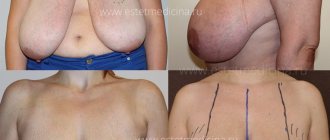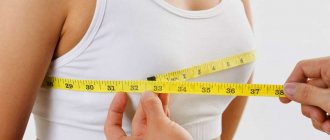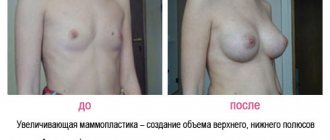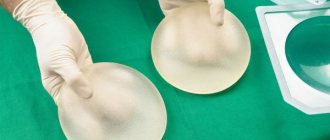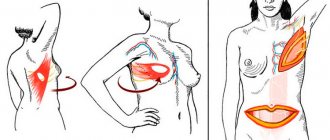Some women become depressed after giving birth, which is partly caused by postpartum negative changes in the body. In the vast majority of cases, childbirth negatively affects the figure: multiple stretch marks appear, body weight increases, and the shape and size of the mammary glands changes. Often their involution (reverse development) occurs after childbirth and breastfeeding, and not a trace remains of the former bust. In such cases, a woman begins to look for various options for breast augmentation after childbirth.
What are the reasons for breast changes after childbirth?
The condition of the mammary gland is directly dependent on the hormonal status of the body. During pregnancy and lactation, significant changes occur in the soft tissues of the breast, especially in the glandular component responsible for breastfeeding. Firmness and elasticity depend on the severity of these changes. If the muscular frame and ligamentous apparatus of the chest are not able to support the mammary glands that have sharply increased in volume, then ptosis occurs - drooping of the breasts with loss of their usual shape and volume. In some cases, immediately after the end of the lactation period, involution appears - the replacement of glandular structures with connective tissue. In this case, the mammary gland loses its soft consistency and decreases in size.
It is impossible to give the mammary glands an ideal appearance that meets the desires and expectations of a woman using conservative methods. In addition, in addition to external characteristics, it is necessary to take into account the consistency of the breast to the touch. All of the above indicators are achieved only with the help of mammoplasty. Nowadays, the methods for performing it have been refined, and the operation is available to everyone.
It is almost impossible to restore the condition of the breasts after childbirth and breastfeeding without surgical intervention, but it is still possible to slightly improve the appearance and correct the shape. Visible results can be achieved using a comprehensive and long-term approach that requires consistency, patience and endurance.
How to restore previous forms
Of course, pregnancy, childbirth and breastfeeding have a detrimental effect on the beauty of a woman’s breasts. However, if you think about preventing this irreversible process, then even in the early stages of pregnancy you can reduce undesirable consequences to a minimum. In order to protect a beautiful bust, you need:
- Buy special bras for pregnant women. You can use regular underwear, but it is very important to take into account that the size should fit well, the cups should stretch, and the straps should be as wide as possible. There should be no discomfort when wearing such a bra.
- You should sleep in underwear designed to support your breasts.
- Daily use of special creams and gels for stretch marks will help keep the breast skin elastic and prevent ptosis.
- It is not recommended to sleep on your stomach.
- Daily physical activity on the chest muscles will help them stay in optimal shape and strengthen the muscle frame.
- While taking a shower, you should perform an aqua massage; to do this, direct a stream of warm water onto your chest and make circular movements clockwise.
- When feeding the baby, apply it alternately to both breasts.
- You should not suddenly stop breastfeeding. This is done gradually and can take several months if necessary.
- When you finish breastfeeding, you should not limit your diet until the body is completely restored. During this period, the replacement of glandular tissue with adipose tissue should occur naturally.
See also: Pain in the lower abdomen and lower back in a woman: causes, diagnosis, treatment
Do not forget about the need for self-examination of the mammary glands. At least once a month, examine yourself in the mirror to check for changes in your breasts. If you notice any lumps, rashes or abnormal discharge, you should immediately consult a doctor.
Tips to Maintain Breast Size and Shape
To avoid unpleasant postpartum breast changes and not look for ways to correct them later, follow these simple tips:
- Follow the principles of proper nutrition. The basis of the diet should be healthy and natural products prepared by boiling or stewing. The second rule is completeness and diversity. The diet must include all the necessary vitamins, otherwise the skin will lose its firmness and elasticity, which will also affect the breasts.
- Every evening, spend 15 minutes massaging your chest. It is extremely necessary during lactation. Massage prevents stagnation of milk, normalizes blood circulation and the outflow of venous blood and lymph, which again has a positive effect on the condition of the soft tissue of the mammary gland. In addition to the classic one, you can use water massage techniques. This does not require special preparation; just consulting with your doctor and purchasing special shower heads is enough.
- Optimize your baby's feeding process. Find a comfortable position and a time period during which the child is completely satiated (usually 15-20 minutes). The feeding position should be comfortable for both mother and baby. A sign of a correctly chosen position is the absence of discomfort or pain when staying in it for more than 20-25 minutes.
- Use cosmetics for skin care. In order to prevent the occurrence of stretch marks, it is recommended to alternate peeling creams and moisturizers. Scrubs should not be used more often than 1-2 times a week, otherwise there is a risk of microtrauma to the skin.
Causes, features of mastoptosis
Sometimes mastoptosis can occur after pregnancy and childbirth, after completion of breastfeeding, when its size gradually decreases.
This is accompanied by psychological discomfort associated with changes in the shape and size of the breast, and body contours. In this case, you need to contact a plastic surgeon; he will tell you what to do if your breasts are sagging, and how the defect can be corrected. In addition to childbirth, changes in breast tissue and breast sagging can be affected by:
- sharp hormonal fluctuations during certain periods of life, leading to weight gain or sudden loss;
- weakness of the pectoral muscles that support the mammary glands;
- large breast size, back problems leading to stooping, which causes the skin of the chest to stretch more;
- aging of the body, the onset of menopause, decreased levels of female hormones.
In some cases, doctors find it difficult to answer why breasts sag. The reason may be the genetic characteristics of the organism.
How to tighten your breasts after childbirth?
Of course, the optimal method for correcting the shape of the mammary glands is surgical plastic surgery. But you can achieve a certain result using the following methods:
- Regular training with dumbbells or body weight.
- Film wraps and compresses after the usual cosmetic skin care procedures (warm shower, peeling, tonic creams).
- Traditional or water massage, contrast shower.
You shouldn’t expect dramatic changes from such methods, but you shouldn’t neglect the tips listed above. Constant and complete body care will reduce the negative consequences for the breasts in the postpartum period to a minimum.
Have questions? Ask:
With a significant degree of ptosis
When the level of nipple sagging almost reaches the level of the navel (grade 3-4), not only a breast lift is required, but also excision of excess tissue (reduction). Moreover, in the first case (mastopexy), only excess skin stretched as a result of gravitational ptosis is removed. And during reduction, part of the mammary gland is also removed (for example, if after childbirth the breasts have become too large and difficult to wear).
Benign changes in the breast
Not every breast tumor is cancer, i.e. malignant tumor. For every one malignant tumor there are ten benign ones. Benign breast changes are very common and appear in women under twenty years of age.
One of the most common benign lesions is fibroadenomas, which are formed as a result of the growth of glandular and fibrous tissue. These changes are most often located in the upper quadrants of the gland. They have the form of a well-defined, elastic, painless, easily movable tubercle with a diameter of 1-3 cm. Fibroadenomas do not increase the risk of developing breast cancer, but it is recommended to remove them, as they can reach a size of 10-20 cm (during pregnancy or taking contraceptives) .
In women aged 45-55 years, cystic fibrosis dysplasia often occurs, characterized by the appearance of numerous or single cysts in the breast parenchyma. Most of them are asymptomatic, some may present with minor pain or increased breast tenderness before menstruation.
This disease is a consequence of chronic hormonal disorders, so it is necessary to carry out tests for the concentration of hormones (estradiol, progesterone, testosterone, prolactin, thyroid hormones).
Cysts may also appear in the breast, which usually feel like a flexible lump. If the presence of a cyst is confirmed by ultrasound, it should be punctured and the resulting contents examined for the presence of cancer cells. With small cell lesions, as well as with large cysts, breast cancer can develop.
Contraindications to reduction mammoplasty:
- The presence of infectious and inflammatory diseases;
- Chronic diseases of internal organs;
- Exacerbation of chronic diseases;
- Disruption of the cardiovascular system;
- Blood clotting disorder;
- Diabetes;
- Beginning of the menstrual cycle;
- Mental illnesses;
- Skin tendency to form keloid scars.
Breast reduction surgery is quite complex and lengthy, however, it is in demand among women and therefore deserves attention. The possibility of a breast reduction or lift (mastopexy) must be discussed with a plastic surgeon, since each specific case is unique, and in some cases, a lift can be supplemented with local liposuction.
Breast reduction cost
| Name | Price |
| Primary appointment (examination, consultation) with a plastic surgeon | FOR FREE |
| Breast reduction (surgical reduction mammoplasty) on both sides, category 1 | 280,000 rub. |
| Breast reduction (surgical reduction mammoplasty) on both sides, category 2 | 300,000 rub. |
Breast reduction - before or after childbirth?
Plastic breast reduction after childbirth is a fairly common surgical correction. Reduction mammoplasty should be done after childbirth, and not before. And there are several reasons for this.
Firstly, if you have undergone breast reduction and correction, nipple-areolar complex, and after some time (up to 1.5 years from the date of surgery) gave birth to a child, then he will have to be fed exclusively with artificial formula. That is, lactation is strictly prohibited.
Secondly, after breast reduction before childbirth, there will be a need to take special medications to suppress the lactation process.
And finally, thirdly, everyone knows the fact that during pregnancy changes in the mammary gland occur, regardless of whether surgery was performed or not. In addition to the aesthetic problem, physical discomfort also appears. Do you need repeated surgery, which puts stress on the body?
Therefore, before deciding to undergo breast reduction surgery, we advise you to think it over by consulting with a specialist.
The most favorable period for having a breast reduction is 6-8 months after birth or, if you are breastfeeding, then 6-8 months after cessation of lactation (feeding).
Breast examination after breast augmentation with implants
Every woman should take care of her health and know that after 35 years it is necessary to undergo breast ultrasound and fluorography once a year. And after breast augmentation, this is extremely necessary. But most girls after plastic surgery wonder whether the examination after the operation will be reliable, and whether all areas of the breast will be visible on the machines.
It is very important to take care of yourself and think about the future, so it is necessary to undergo all examinations on time. Will implants interfere with ultrasound, mammography, CT, MRI? This is the most popular question among women who have had breast enlargement. The answer is no! The presence of breast implants will not affect the examination in any way, and will not interfere with the eventual establishment of an accurate diagnosis, provided that the examination is carried out using modern technology.
Before the examination, it is recommended to carefully select a clinic. As a rule, all modern clinics are equipped with the latest models of technology. It is recommended to first clarify whether it is possible to conduct an examination of breasts with implants, and also consult with a specialist who will select the most suitable examination method.
Types of examinations:
1. Ultrasound - ultrasound examination
. An ultrasound must be done before plastic surgery, and then repeated annually after it. Today this is the most common examination method. Ultrasound allows you to study the mammary glands before surgery, as well as exclude various kinds of complications, inflammation and adverse changes already during the rehabilitation period.
2. Mammography
. Despite the fact that mammography is the most accurate method of breast examination, it still has some difficulties. In cases where the implant was installed above the pectoral muscle, during the examination it may block some areas of the breast. If the implant is installed under the muscle, the blocked area is insignificant. The disadvantage of this method is that it will not help determine whether a breast implant is ruptured or leaking. When performing mammography, each gland is compressed first horizontally, then vertically, so the patient should warn the doctor in advance about the presence of breast implants in the mammary glands.
3. MRI - magnetic resonance imaging
. The peculiarity of the method is the use of a powerful magnetic field. MRI allows you to determine implant rupture or leakage, identify tumor foci and metastases.
4. CT - computed tomography
. This type of examination is considered the most accurate for diagnosing breast cancer. Computed tomography is classified as an X-ray method for examining the breast.
5. Fluorography
. Breast implants are visible in the fluorography image. The patient should notify the doctor in advance about their presence, but they will not interfere with the examination of the lungs, because implants easily transmit x-rays.
Thus, the presence of breast implants will not interfere with any of the listed types of examinations and obtaining accurate data on the condition of the patient’s mammary glands and lungs.
How to make your breasts firm and firm after breastfeeding: ways
Water will moisturize the skin, which will quickly begin to tighten. The method is not the most pleasant and comfortable, but it has been used for many generations.
Common products in the civilized world are special-purpose creams. Without surgery, they can enlarge small breasts.
Give elasticity and shape to a large bust. The products have a powerful skin cell regenerating effect.
Breast tightening creams:
- ✅ DUO GUAM. Specialized product for breast lift. Has the ability to reduce stretch marks on the skin. Collagen and vitamins in its composition tighten the skin of the breast.
- ✅ Organic Kitchen anti-gravity. The tightening effect can significantly raise the bust. Moisturizes, nourishes and protects the skin.
The creams also contain hormonal supplements. It must be remembered that a woman’s breasts are mainly glandular tissue.
You can tighten your bust by replacing glandular tissue with muscle. This is why professional athletes have almost no breasts.
Important! For the best effect, an integrated approach is required: playing sports and doing physical exercises, normalizing nutrition, care with cosmetics.
Breasts can take on the best shapes if they are properly treated, cared for and cared for. You need to wear it proudly, and not drag it from work to home and back.
Exercises
In order for sagging breasts to acquire a beautiful shape, you will have to choose a set of exercises aimed at tightening and forming a muscular frame to support it.
Fitness trainers say the best exercises for this are push-ups and planks, so they should be performed daily as part of your morning exercises, and additionally three times a week when workouts are scheduled.
Push ups
Not every woman knows how to do push-ups. If this is difficult, first practice push-ups from a wall, then from a bench or chair, and only then move on to the classics. In the morning, 10 times will be enough, and during training, do 3 sets of 10 times with an interval of 1 minute.
Bench press
The bench press is a great option for toning your muscles and increasing chest muscle mass. A simple exercise will help your bust look fuller.
Procedure: Lie with your back on the bench. You will need dumbbells. Your arms should be bent at an angle of 90 degrees at the elbows (parallel to the floor). Raise the dumbbells up and hold your hands in this position for several seconds. Next, return to the starting position. Do 3-5 sets of 15 reps.
Dumbbells can be replaced with water bottles.
Plank
This exercise will be effective only if 2 conditions are met. Firstly, it must be performed correctly. Watch training videos; at the initial stage, ask someone to check whether you are stretching your body evenly and whether there are any arches or sagging. Secondly, it needs to be done incrementally. There is a certain scheme when on the first day you stand in the plank for only 20 seconds, and by the end of the month they turn into 5 minutes. Follow it.
Lock
Bend your elbows and press your palms tightly together at chest level. Start pressing them with force (20 seconds), then relax (10 seconds). Do 10 approaches.
"Breast butterfly"
The “pectoral butterfly” exercise stretches the pectoral muscles well, strengthening them and improving posture.
Procedure: Lie down on a bench and keep your feet on the floor. Raise your arms with dumbbells and bend your elbows, holding them above your chest. This is the starting position. Take a deep breath and slowly extend your arms out to the sides until they are parallel to the ground. During the exercise, you will certainly feel a stretch in the chest area. Exhale and return to the starting position. Do 5 sets of 15 repetitions. Please note that you should not feel pain during the exercise.
If you feel discomfort, it means something is being done wrong.
Cobra
Lie on your stomach, straighten your legs. Position your hands as if you were doing push-ups. Raise the upper part of the body at an angle of 90° without lifting the lower part from the floor. Hold for 20 seconds. Return to starting position. Repeat 10 times.
Tree
Stand up straight. Raise your arms up, clasp your palms above your head. Raise one leg and place its foot on the inner thigh. Hold in this position for 30 seconds. Return to starting position. Change leg. The number of repetitions for each leg is 5. If you cannot maintain balance, perform the exercise next to a wall, which will serve as a support for the first time.
Also perform arm swings with weights, dumbbell presses (no more than 1 kg each), and a bridge (read how to stand on it here). Many yoga asanas work the pectoral muscles. In addition to exercise, some sports contribute to tightening: swimming and water aerobics. But it’s better not to get carried away with team issues.
And 2 more recommendations from fitness trainers for those who want to achieve good results. Don’t get carried away with cardio exercises: the emphasis should be on strength training. Jumping and running make the chest flat and expressionless. And don’t forget to wear a sports bra to workouts and classes.
Breast massage
Knowing the basic massage techniques, the question of how to restore breasts after losing weight will no longer bother you. Use light stroking movements over the entire décolleté and chest area. This way you can warm up the skin and ensure blood flow (2-3 minutes); Next, lightly tap the chest with your fingertips, starting from the juices (3-4 minutes); Using pinching movements, go over the entire décolleté and chest area. Manipulations should not cause discomfort or leave redness on the skin; A vibrating massage helps tighten your breasts. You need to place your palm just above the nipple and lightly vibrate it for 30 seconds. In the same way, you need to go over the entire chest, including the décolleté area. The total time to perform vibration is 5-8 minutes; We finish the massage with light stroking.
Cosmetology procedures
All kinds of masks, applications, creams, lotions, wraps and other additional cosmetic delights will not be able to return your breasts, which are losing weight along with you, to their former heights. But they are able to retouch such consequences as stretch marks, small wrinkles, loss of tone.
In general, when using them, you are provided with a cosmetic effect without major changes.
- ✅ Tightening masks and scrubs. The market is replete with specially designed lifting products, but natural cosmetics can also be effective. For example, a tightening mask of bananas and honey (one mashed banana - a tablespoon of honey, applied to the décolleté for half an hour).
- ✅ Cocoa butter wonderfully tightens the skin and removes stretch marks. At the same time, it is not very expensive.
- ✅ Cream. For breast care, regular body cream is suitable. You can also add a little castor oil to any moisturizer. It's cheap and very effective. The skin on your décolleté will noticeably improve and tighten.
Water treatments
- ✅ Contrast shower. Alternating cold and hot water is a wonderful remedy for breast tone. Even if you are just taking a bath, finish your water procedures with a douche of cold water. You can also wipe the décolleté area, including the neck, with an ice cube.
- ✅ Hydromassage. For 8-10 minutes, massage yourself with a stream of warm water of medium pressure in the décolleté, shoulders, chest, and intercostal area. This stimulates blood circulation, has a beneficial effect on the skin and increases the tone of the chest muscles, which means it promotes its elasticity.
Attention! All cosmetic, water treatments and massages to maintain and lift the breasts should cover the entire breast, excluding the nipples and dark areola circles around them.
Because these are the most sensitive places and are rich in blood vessels, as well as the endings of the milk ducts.
Mammary cancer
Breast cancer is one of the most common and dangerous malignant tumors in women. The risk of developing breast cancer increases with age, with the highest incidence occurring between ages 50 and 70.
Main risk factors for developing breast cancer:
- environmentally unfavorable city;
- early age of first menstruation (up to 12 years);
- late age of menopause (after 55 years);
- first birth after 30 years;
- obesity;
- mild changes in the chest;
- infertility;
- breast cancer in close relatives;
- irradiation.
Breastfeeding (even short-term) protects against the development of breast cancer.
The use of hormone replacement therapy increases the risk of developing breast cancer by approximately 6% and with use for more than 10 years the risk increases to 30%.
Nipple discharge
Nipple discharge that appears in a woman after a feeding period is not always a sign of illness, but requires consultation with a mammologist.
A small amount of discharge with the appearance of milk or whey often appears in women taking oral contraceptives or other medications, including sedatives. Most often, lactation is caused by hyperprolactinemia, which is a symptom of a problem with the pituitary gland.
Bloody discharge from the nipple is most often a symptom of papilloma or cancer. Brown or green discharge is associated with cystic fibrosis breast disease.
In case of discharge from the nipple, you must visit a gynecologist and determine the cause of the disease and the type of treatment.
Breast self-examination
Palpation should always include the nipples and lymph nodes on both sides of the body. Particular attention should be paid to the upper and lateral quadrants of the breast, since it is there that about 50% of malignant breast tumors are localized. It is best (for menstruating women) to examine the breasts in the first week after the end of menstruation.
When examining your breasts, special attention should be paid to the following facts:
- venous vessels have become more visible through the skin;
- changes in skin color or texture;
- changes in the size or shape of one of the breasts;
- dimples, wrinkles, or sores on the nipple or breast skin;
- changes in the shape or contour of the breast, nipple;
- changes in appearance: redness, scabs, peeling of the epidermis;
- bleeding or leakage of nipple discharge;
- swelling of the hand;
- “orange peel” skin;
- the presence of a new nodule that does not disappear after menstruation and does not respond to hormonal changes in the menstrual cycle.
Postoperative period
The rehabilitation period after reduction mammoplasty is approximately the same as with breast augmentation. However, due to the larger volume of intervention, the recovery period becomes longer.
In the first days after breast reduction (reduction mammoplasty), there is a slight increase in body temperature and tolerable pain in the chest area. It is natural for swelling to form in the operated area. It takes time for the mammary gland tissue to recover (the swelling subsides completely after 2-3 months).
A hospital stay is necessary for 3-5 days under the supervision of a surgeon. Sutures after breast reduction surgery are removed after 2-3 weeks if non-absorbable suture material was used. The use of absorbable sutures during breast reduction surgery eliminates the need to remove stitches.
For a month to a month and a half after reduction mammoplasty, the breasts need rigid fixation and support: it is necessary to wear compression garments.
You also need to limit lifting weights (do not lift more than 1.5 kg), do not visit the bathhouse, sauna, or public swimming pool.
Due to the fact that breast reduction is a fairly invasive operation, patients during the rehabilitation period require increased attention to hygiene and dressings in the chest area, as well as taking prescribed antibacterial drugs.
Also, after breast surgery (reduction), some complications are possible, which the patient should be aware of in advance. After breast reduction, skin necrosis may occur, which most often affects the area of the areola and nipple. In most cases, this complication is explained by a poorly performed operation. Another complication is inflammatory processes, which are prevented by taking special medications and the utmost care of the surgeon. In older patients, blockage of blood vessels by fatty tissues and hematomas after breast reduction are possible.
In order to avoid complications after breast reduction, the patient should discuss in advance the possibility and likelihood of their occurrence, and also carefully follow all recommendations in the postoperative period, take care of herself and, if any pain or unknown tissue changes occur, immediately contact her surgeon.
Breast reduction surgery is quite complex and should only be performed by an experienced surgeon who specializes in mammoplasty. The price of the operation, of course, is not small, but it is fully justified by the volume of surgical intervention, medical responsibility and the peculiarities of the recovery period during which it is necessary to visit a doctor. The cost of breast reduction in a clinic (in Moscow) is from 150,000 rubles.
Is mastopathy inherited?
The cause of mastopathy is a woman’s hormonal imbalance. Ovarian dysfunction, problems with the thyroid and pancreas, pituitary gland, adrenal glands, constant stress - all these abnormalities inevitably affect the hormonal background and lead to mastopathy.
To minimize possible breast problems, you may need to reconsider your lifestyle:
- stress must be avoided. Any stress is a certain chemical reaction in the body that occurs with the participation of hormones and inevitably leads to their imbalance. Don't forget about your personal life. By constantly refusing sex, you contribute to the development of psycho-emotional stress and provoke functional disorders of the nervous system
- eat right. Excess cholesterol and a lack of fruits and vegetables in the diet threatens not only extra centimeters at the waist and hips, but also problems with the breasts. Low-calorie diets are just as harmful. To never find out what mastopathy is, do not forget about the rules of a healthy diet and vitamins
- choose comfortable underwear. Of course, a bra cannot be blamed for having a bad effect on hormonal levels. However, tight underwear with metal underwires (although very seductive) tightens the breasts and leads to microtraumas, which undoubtedly cannot be beneficial. So choose bras with plastic underwire or whalebone underwire.

